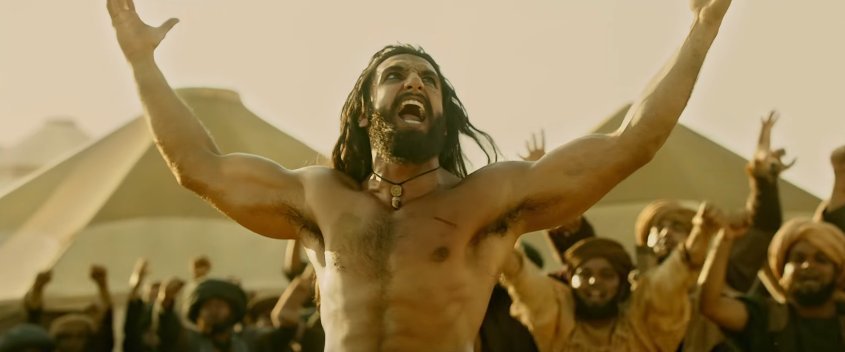The trailer of Sanjay Leela Bhansali’s Padmavati was as spectacular as one expects from a director who has perfected his signature style and, in fact, raised the bar film after film – the actors appear more royal, the sets more opulent, the war scenes grander, the visuals breathtaking.
Stunning. Outstanding. Brilliant. Wow.
Amidst all the acclaim and fanfare, it is Ranveer Singh’s truly eye-catching look as Alauddin Khilji that garnered the most attention, and not just for its striking similarity to Game of Thrones’ Khal Drogo. He looks every bit as vicious and menacing as one would imagine the villain to be, who laid siege to Chittor to fulfil his lustful quest of the legendary Rani Padmini (Padmavati).

Except therein lies the problem, the depiction of a real-life medieval ruler as a monster, whose appearance and mannerisms have more in common with a tribal leader from a fictional world rather than any actual historical figure from the times he represents. Alauddin may have been a ruthless leader, but he was no Gabbar. And to show the most powerful king of the Khilji dynasty as a barbaric, meat-eating, depraved savage is not only factually wrong, it also perpetuates a harmful misconception about the already misunderstood and much-maligned Islamic rulers.
No one expects works of historical fiction to stay true to facts, least of all Bollywood movies. (The fanciful Mohenjo Daro was as grounded in reality as the flying crocodile in it that attacked Hrithik Roshan.)

In fact, for those who don’t know, the entire premise of Padmavati is based on a 16th-century text that historians largely agree was a work of historical fiction by its author Malik Muhammad Jaisi. (Yes, this story of Rajput valour in the face of Muslim attack was written by a practising Muslim.) There is no mention of this story in any written sources before that. In fact, as explained by historian Aziz Ahmad in his article ‘Epic and Counter-Epic in Medieval India’, it is likely that Jaisi made up this story to appeal to his largely Hindu audience, something he himself confesses at the end of his tale.

None of this matters in the context of the movie, however. And if Jaisi could take liberties to tell a good story way back in the 1540s, why not Bhansali now in 2017? Let’s face it – the saga of an evil king who goes to war to capture a beautiful queen is far more enthralling than a conquest motivated by the relatively more mundane demands of an expanding medieval kingdom, such as subjugating a powerful rival state to gain control over land routes crucial for trade, wealth and horses. Yawn.
So no, the issue isn’t with the inaccuracy of the story or the obvious cinematic liberties Bhansali takes to tell it, but with Khilji’s depiction as the sinister antagonist whose appearance seems to be based on crude stereotypes rather than any creative re-creation of what a king in those times may have looked like.

Of course, none of these rulers, be it, Akbar, Alauddin or Ratan Singh, were as good-looking as Hrithik, Ranveer or Shahid Kapoor. They never had waxed chests or six-pack abs. But the long hair and beard, the heavy soorma in the eyes, the beastly manner in which he eats meat and the hard-to-miss crescent on his flags – the imagery could not be more clear to establish Khilji as the Muslim ‘other’, in direct contrast to the sophisticated Hindu he attacks. Such a portrayal will only add fuel to the fire of the ‘us-versus-them’ trope that is already dangerously pervasive in the current environment. (Imagine WhatsApp messages eulogizing the courage of the Rajputs who fought the ‘invader’ Alauddin to protect the ‘faith’.)

History is not an easy subject to understand, with much to argue over facts, analysis and interpretations. No wonder it is a hard task to make a period film when even historians can’t agree on one definite narrative or provide details to fill in the gaps. But Bollywood has an influence like no other.
The classic Mughal-e-Azam had a large hand in convincing people that Akbar had only one wife whose name was Jodha Bai (not true); the last thing we need now is for Bhansali’s epic to stick the wrong idea in everyone’s head about what Alauddin Khilji was like. It is about time that directors and writers shoulder some responsibility and at least attempt to treat these subjects with sensitivity and some deference to history. Otherwise, we will further confuse society’s already inadequate knowledge and poor understanding of our history. Which, in these times, can lead to serious repercussions.

Meanwhile, while propelling Padmavati to the 400-crore club (or whatever the latest figure it stands at), one hopes that most viewers will remember that there is as much truth to the events depicted in this movie as there was to those in Bhansali’s previous offering Bajirao Mastani or serial offender Ashutosh Gowariker’s Jodhaa Akbar. In fact, maybe the film will motivate people to read more about the actual history of the times and gain a better understanding of the complexities of our past. The trailer certainly sent me back to my books after a long hiatus of nine years.
Much wow, indeed.
The opinions expressed in this article are the author’s own and do not reflect those of ScoopWhoop.
Feature image source: Bollywood 2017
















